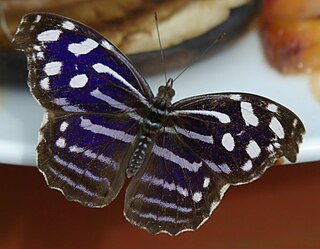
Thecla was a saint of the early Christian Church, and a reported follower of Paul the Apostle. The earliest record of her life comes from the ancient apocryphal Acts of Paul and Thecla.

The Acts of Paul and Thecla is an apocryphal text describing Paul the Apostle's influence on a young virgin named Thecla. It is one of the writings of the New Testament apocrypha. Edgar J. Goodspeed called it a "religious romance"

The brown hairstreak is a butterfly in the family Lycaenidae. The range includes most of the Palaearctic.

Biblidinae is a subfamily of nymphalid butterflies that includes the tropical brushfoots. This subfamily was sometimes merged within the Limenitidinae, but they are now recognized as quite distinct lineages. In older literature, this subfamily is sometimes called Eurytelinae.

Cogley Wood is a 60.7 hectare biological Site of Special Scientific Interest east of Bruton in Somerset, notified in 1987.

Thecla is a genus of butterflies, described by Johan Christian Fabricius in 1807, belonging to the family Lycaenidae. The species are found in the Palaearctic.
Thecla, Tecla, or its variants is a Greek feminine given name made famous by Saint Thecla, a 1st-century Christian martyr.

Chrysozephyrus khasia, the tailless metallic green hairstreak, is a small butterfly found in India that belongs to the lycaenids or blues family.

Chrysozephyrus paona, the Paona hairstreak, is a small butterfly found in India that belongs to the lycaenids or blues family.
Thecla pavo, the peacock hairstreak, is a small butterfly found in India that belongs to the lycaenids or blues family.
Thecla letha, the Watson's hairstreak, is a small butterfly found in India that belongs to the lycaenids or blues family.
Thecla ziha, the white-spotted hairstreak, is a small butterfly found in India that belongs to the lycaenids or blues family.

Esakiozephyrus icana, the dull green hairstreak, is a small butterfly found in India that belongs to the lycaenids or blues. The species was first described by Frederic Moore in 1874.

Sarangesa thecla, also known as the common elfin, is a species of butterfly in the family Hesperiidae. It is found in Guinea, Sierra Leone, Liberia, Ivory Coast, Ghana, Togo, Nigeria, Cameroon, Gabon, the Republic of the Congo, the Central African Republic, the Democratic Republic of the Congo, Uganda, Kenya and Tanzania. The habitat consists of dry semi-deciduous forests.

Ocaria ocrisia, the black hairstreak or Hewitson's blackstreak, is a butterfly of the family Lycaenidae. It was described by William Chapman Hewitson in 1868. It is found from Mexico to Brazil, Paraguay, Peru, Ecuador and Argentina. It has also been recorded in southern Arizona. The habitat consists of rainforests at altitudes ranging from 200 to 900 meters.

Thecla betulina is a butterfly of the family Lycaenidae. It was described by Otto Staudinger in 1887. It is found in the Russian Far East, north-eastern China and Korea. The species is found in the forest belt where it inhabits forest edges and river valleys.

Calycopis pisis, the pisis groundstreak, is a butterfly found in several countries in Latin America.

Ipidecla schausi, also called Schaus' hairstreak or Salvin's dwarf, is a small butterfly in the family Lycaenidae, sub-family Theclinae and genus Ipidecla.














